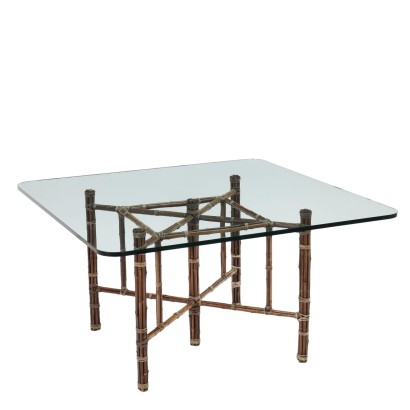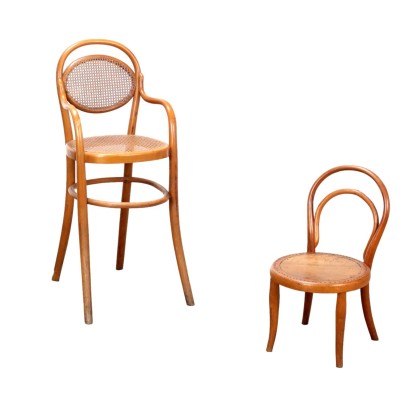Ancient Coffee Table Napoleon III Late '800 Bois de Violette - France, Late XIX Century
Features
France, Late XIX Century
Style: Napoleon III (1848-1870)
Age: 19th Century / 1801 - 1900
Origin: France
Material: Gilded Bronze , Exotic Wood Veneer , Bois de Rose Veneer , Glass
Description
Napoleon III side table in marquetterie exotic wood and bois de violette, France, late 19th century. Upper surface equipped with a removable glass tray and connected to the lower surface by wavy uprights. Entirely decorated with finely chiseled gilded bronzes, used to make the edge of the tops, the handles and the classic-style applications depicting corncucopias, leafy and floral elements, ribbons and masks. The goat-shaped shoes are also in gilded bronze. Restored.
Product Condition:
Product restored by the experts of our restoration laboratory. We try to present the real state as fully as possible with photos. If some details are not clear from the photos, what is reported in the description will prevail.
Dimensions (cm):
Height: 91,5
Width: 83
Depth: 51,5
Additional Information
Style: Napoleon III (1848-1870)
With Napoleon III as emperor, France experienced a period of extraordinary economic prosperity, a factor that allowed it to reconstitute a formidable war machine.In short, the dream that had once been Bonaparte's was revived: France as a great European hegemonic power.
The euphoria and grandeur also found perfect correspondence in the furnishings that characterized the Second Empire.
In Italy, the Napoleon III Style initially had insignificant effects, imposing furnishings in imitation of Louis XVI with an ornamental value resolved only in carving and completely devoid of bronze frills, in deference to a more sober taste that would always characterize Italian clients.
Only in the first decades of the twentieth century did "French" furniture find important commercial outlets in our country.
This is the name given to the artistic production of France under Napoleon III, president in 1848 and emperor from 1852 to 1870, the year of his abdication.
Rather than a style, we can speak of a set of styles, or rather revivals, given that in these years the eclectic tendency that had already appeared during the previous reign of Louis Philippe developed to its extreme consequences.
The drive to re-evaluate history and the Middle Ages also derives from the romantic spirit, as well as from the nationalistic one.
The houses were therefore furnished by mixing different styles and drawing from both the past and the East, with a tendency towards luxury and pomp that reflected the emperor's desire for grandeur.
In general, there was a return to the entire 18th century, with particular attention to Louis XVI; the fashion for dark woods (ebony and rosewood), exotic woods and bronze applications is confirmed.
From the 17th century onwards, the inlay created by André-Charles Boulle, the great cabinetmaker of Louis XIV, was revived. He created an inlay technique in gilded bronze and tortoiseshell, in which one of the two materials acts as a background for the perforated designs of the other.
Compared to the refinement of the original pieces, the "Boulle" furniture of this period is heavier and also flashier, given the addition of bright colours through painted sheets or parts in horn coloured blue, red or green.
Always in the wake of eclecticism, Venetian furniture arouses particular interest, which stimulates the production of polychrome and gilded furniture, in which figures of Moors often appear as supports.
These latter are also linked to the passion for the exotic that leads to the fashion for chinoiserie (in especially after the conquest of Beijing in 1860).
Discover more about the Napoleon III style with our insights:
a Napoleon III Secretaire to discover the cabinet with hiding places
A Napoleon III table to discover the caryatid
FineArt: Chandelier – O. Lelièvre & Susse Frères, Paris, last quarter of the 19th century
FineArt: Napoleon III Sideboard
The Austrian taste of Baroque
The Louis XV cabinet
The history of the writing desk
Napoleone III: the charm of the exotic in furniture
Age: 19th Century / 1801 - 1900
19th Century / 1801 - 1900Material:
Gilded Bronze
Exotic Wood Veneer
Bois de Rose Veneer
Glass
Other customers have searched:
Approfondimenti
Se ti interessano tavoli, tavolini, tavoli a vela, scrivanie, scrittoi e consolle dai un'occhiata ai nostri approfondimenti sul blog...L'antiquariato dalla A alla Z: il Dizionario dell'Antiquariato
Il dizionario dell'antiquariato - Lastronatura
Il dizionario dell'antiquariato - Mascherone
Il dizionario dell'antiquariato - Natura morta
Il dizionario dell'antiquariato - Opificio
Il dizionario dell'antiquariato - Pastiglia
Il dizionario dell'antiquariato - Savonarola
Il dizionario dell'antiquariato - Rosone
Intaglio barocco con motivo a ricciolo
Sui tavoli:
Il Neobarocco in un grande tavolo dell'800
Il Tavolo a fratino
Sui tavolini:
Breve storia dei tavolini
Un tavolino impero lombardo: segno di egemonia politica
Il tavolino da gioco, questo sconosciuto
Il dizionario dell'antiquariato – tavolino a Commesso
...e alle presentazioni su FineArt
Tavoli antichi:
Tavolo campionario lapideo, Roma, Opificio Raffaelli
Tavolo a vela, attribuibile a Luigi e Angiolo Falcini
Tavolo attribuibile a Luigi e Angiolo Falcini
Gueridon, Regno delle Due Sicilie, primo quarto XIX secolo
Tavoli modernariato e design:
Archivio Borsani, patrimonio di memorie e saperi
Tavolo anni '40 ABV
Tavolo Mario Vender Anni '60
Tavolo anni '50 ABV
Tavolo '522' Gianfranco Frattini per Bernini
Tavolo 'Barium' Luciano Frigerio
Tavolo anni '50, Manifattura Italiana
Tavolini antichi:
Coppia di tavolini Tomaso Buzzi, attribuiti
Tavolino da gioco, Bottega Giuseppe Maggiolini, inizi XIX secolo
Tavolini modernariato:
Tavolino anni '50
Tavolino anni '40 ABV
Product availability
The product can be seen at Cambiago
Immediate availability
Ready for delivery within 2 working days from ordering the product.



















































